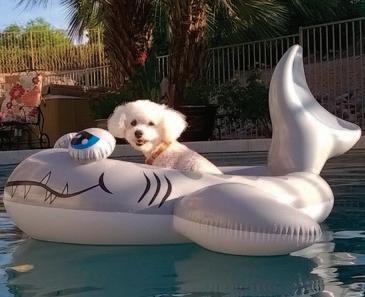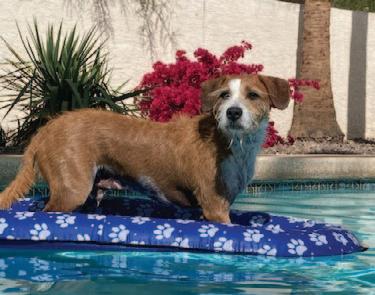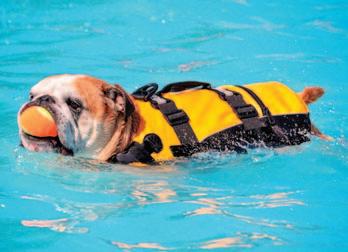
3 minute read
Swimming Pool Safety
Use Knowledge And Vigilance To Protect Your Pet
By Penny Lex
Advertisement
Nothing feels better than a refreshing dip in the ol’ pool during the hot summer season in Arizona. And sharing that experience with your dog, playing in the water while enhancing your bond, makes it even better.
Unfortunately, amidst all that seasonal fun, a staggering number of dogs down each year—over 5,000! Pool safety is often neglected by pet owners as they assume that “dogs can swim” so . . . “all is good.” It is not! There are many factors to consider before plunging into the pool with your pooch. Taking time now to educate yourself, members of your household, and your dog, can help prevent an unfortunate incident from occurring. It can also result in knowing what to do should something happen.
Pool access
While some pools are directly surrounded by a fence, many are not. If your pool is not and your dog has free access to it, consider adding a pool alarm. You could be outside when your dog decides to take a dip. But if you are not constantly watching, it could be just seconds before the dog goes under, and then . it could be too late. An alarm will alert you whether you are in or out of doors when there is activity in the water.
Solar covers
Pool covers can be deceptive to dogs. If a dog somehow gets under the cover and panics, their chances of getting out will be almost impossible. Train your dog to stay away from the pool cover and better yet, fence the area or install an alarm.


Born to swim—or not
While some breeds, like the Newfoundland, Portuguese Water Dog, Standard Poodles, and Retrievers, are born to dog can crawl out the side. Even if the dog has done so once or twice, it is different when the animal is tired and doesn’t have enough strength. That can lead to panic, the dog going down, ingesting water, and drowning. Repeated exercises teaching that the only way in and out of the pool is the steps will help your pet remember this paramount safety measure. swim, there are a host of other breeds that are most likely to drown. Brachycephalic breeds such as Boxers, Bulldogs, Dachshunds, Pugs, and Shih Tzus have short snouts, experience more difficulty breathing while in the water, and tire more quickly and easily. Breeds like Basset Hounds and Corgis have shorter legs and cannot paddle hard enough to keep afloat.
If your pool doesn’t have steps, install a pool ramp that offers easy, safe access.
Pool Rule #1
Train your dog where the steps are located and only allow pool access and exit from that spot. Do not assume your

The swim
It is a dog’s instinct to paddle with the front legs. However, doing that alone creates an abundance of splashing, they are positioned almost straight up and down, and their front end is ineffective while using an abundance of energy resulting in exhaustion. You can help them by giving a little lift to the back end and then moving forward alongside them as they paddle. This will help to get the dog going and teach them what it takes to swim.
Never,
Overexertion
For those dogs that love to play in the water and swim, “one more time” is never enough. They don’t ever want to stop swimming, fetching, or playing— just like kids. When you notice that your dog’s rear-end starts to drop lower in the water, it’s time to stop. Two of the top causes of dog drownings are fatigue and panic. When a dog is tired and gets into trouble, it is easy for them to go down and take in water.
Hydration
It’s important for dogs to stay hydrated— even when in the pool. Chemically treated pool water, however, is not what they should drink. Make sure to have enough fresh, cold water available to quench your dog’s thirst.
Life jacket
For dogs that are just learning to swim, who have physical handicaps, or for your peace of mind, a life jacket is a good investment. Make sure you measure to get a good fit.

Après swim
It’s a good idea to rinse your dog’s coat after being in the pool. It will get rid of chemicals that can sometimes cause skin irritation. Also, be sure to remove a wet collar as that can result in a breeding ground for hot spots.
Learn CPR
Take classes in pet (and human) CPR so you know what to do in case of an emergency.
Dry drowning
Many pet owners aren’t familiar with this condition. It can happen hours or even days after a near-drowning event and it can be deadly. It occurs when water is inhaled, causing pulmonary edema or fluid in the lungs that can lead to respiratory distress or cardiac arrest. Watch your dog carefully when in the water, and if you see him taking in water or there is a near-drowning event, monitor the dog carefully for several days watching for coughing, lethargy, difficulty breathing or wheezing. If those signs occur, take your dog to the veterinarian immediately.
Bottom
Never, ever leave your dog unattended in the swimming pool. No matter how brief of time. It only takes seconds for a dog to drown—but a lifetime for a pet owner to live with the heartache. W










